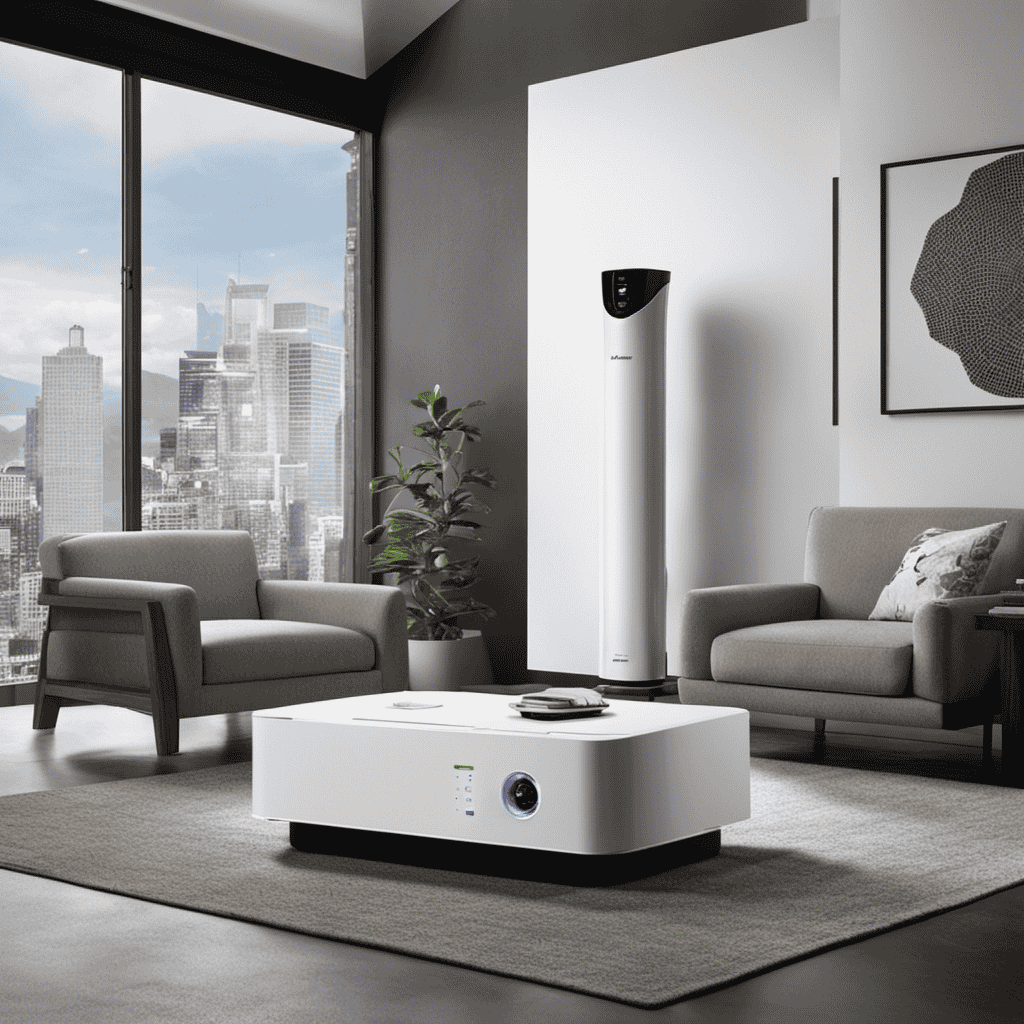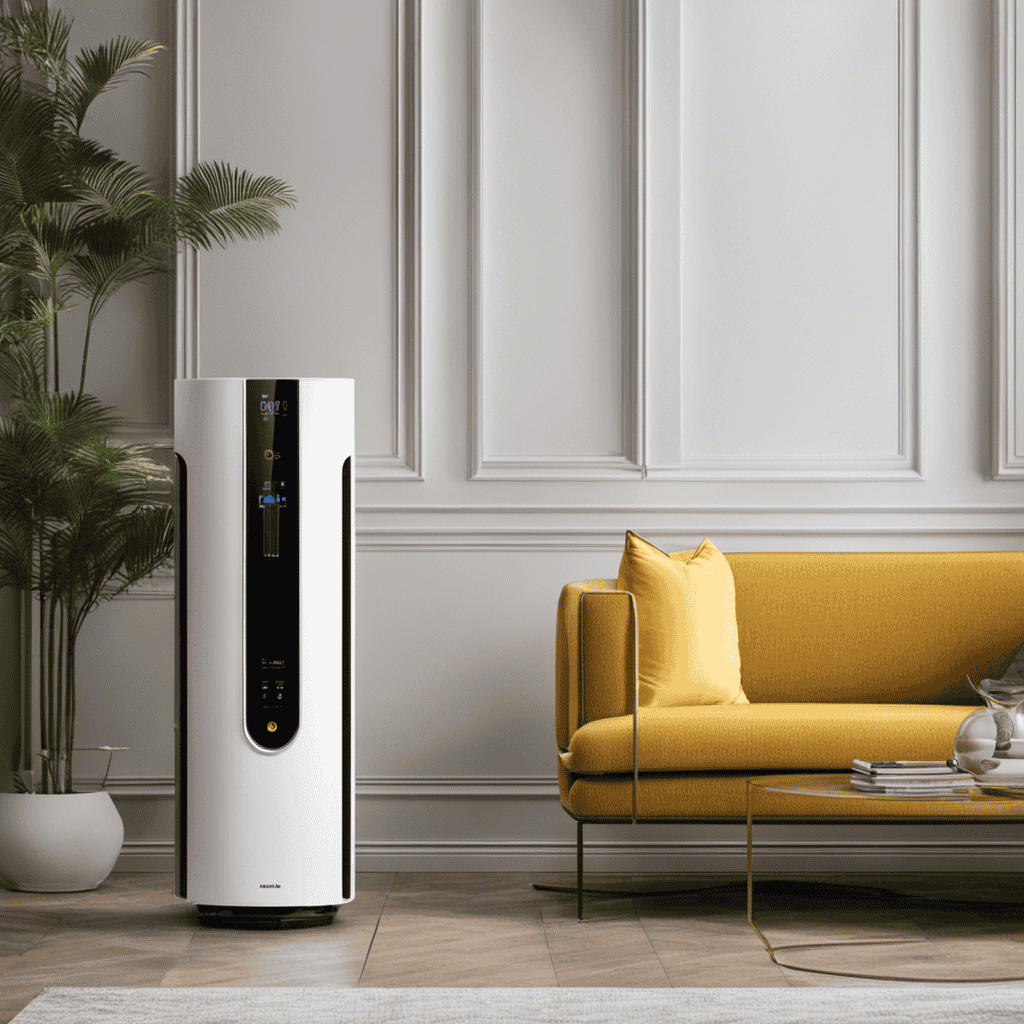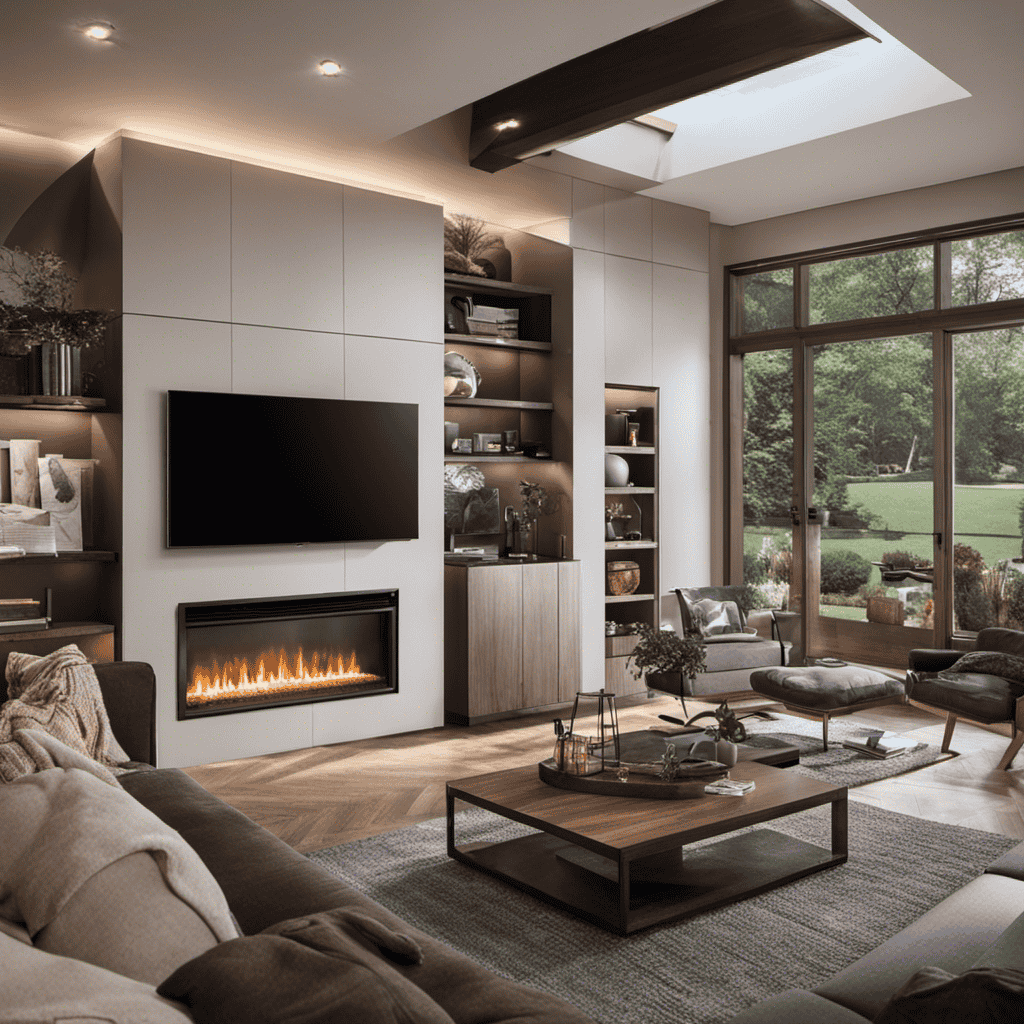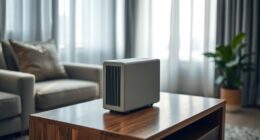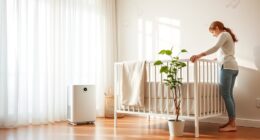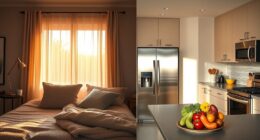Were you aware that the pollution inside homes can exceed outdoor pollution levels by up to five times? This underscores the importance of having an effective air purification system in your residence.
In this article, I will explore the key differences between air purifiers and ionizers. We’ll delve into their unique technologies, functionality, and effectiveness in removing pollutants.
By understanding these differences, you’ll be able to make an informed decision about which option is best for improving your indoor air quality.
Key Takeaways
- Air purifiers use filters to capture and remove a wider range of pollutants, while ionizers release negative ions to attach to and neutralize pollutants.
- Air purifiers are more effective in removing larger particles and certain types of pollutants, while ionizers may not be as effective in larger spaces and can cause uneven purification.
- Air purifiers employ techniques such as HEPA filtration, activated carbon adsorption, and UV germicidal irradiation, while ionizers emit negatively charged ions into the air.
- Air purifiers can improve indoor air quality by reducing allergens and irritants, alleviating asthma and allergy symptoms, eliminating odors and harmful chemicals, while ionizers do not remove particles from the air but make them heavier, causing them to settle on surfaces.
How They Clean the Air
To understand how they clean the air, you’ll need to know that an air purifier uses filters to capture and remove airborne particles. An ionizer, on the other hand, releases negative ions to attach to and neutralize pollutants.
When it comes to effectiveness comparison, air purifiers are generally considered more effective in removing a wider range of pollutants. This includes dust, pollen, pet dander, and smoke. They can also remove larger particles from the air.
On the other hand, ionizers are less effective in capturing larger particles and may struggle with removing certain types of pollutants like dust and pet dander.
As for maintenance requirements, air purifiers typically require regular filter replacements to ensure optimal performance. In contrast, ionizers do not require filter replacements but may need occasional cleaning to remove accumulated particles.
Technology Used
In this discussion, I will explain the different purification methods used in air purifiers and compare the ionization process.
First, let’s delve into the purification methods. Air purifiers employ various techniques such as HEPA filtration, activated carbon adsorption, and UV germicidal irradiation to remove pollutants from the air.
HEPA filtration is a highly effective method that uses a filter to trap particles as small as 0.3 microns. It can remove allergens, dust, pet dander, and other pollutants from the air.
Activated carbon adsorption is another method commonly used in air purifiers. It works by trapping odors, chemicals, and volatile organic compounds (VOCs) in the activated carbon filter, preventing them from circulating in the air.
UV germicidal irradiation is a process that uses ultraviolet light to kill bacteria, viruses, and other microorganisms. It is particularly effective against airborne pathogens and can help improve indoor air quality.
Now, let’s move on to the ionization process. Ionization involves emitting negatively charged ions into the air. These ions attach to airborne particles, making them heavier and causing them to settle on surfaces.
Ionization is often used in combination with other purification methods. It can help enhance the overall effectiveness of an air purifier by reducing the number of airborne particles and improving indoor air quality.
However, it’s important to note that ionization can produce ozone as a byproduct, which can be harmful to human health. For this reason, it’s crucial to choose an air purifier that has a low ozone emission level and meets safety standards.
Purification Methods Explained
The main difference between an air purifier and an ionizer is how they clean the air. Air purifiers work by trapping and filtering airborne particles, while ionizers release negative ions into the air to neutralize pollutants.
Here are the advantages of using an air purifier:
- Removes a wide range of contaminants, including dust, pollen, pet dander, and smoke.
- Improves indoor air quality by reducing allergens and irritants.
- Helps alleviate asthma and allergy symptoms.
- Can eliminate odors and harmful chemicals.
On the other hand, ionizers have some drawbacks:
- They do not remove particles from the air but instead make them heavier, causing them to settle on surfaces.
- Some ionizers release ozone, which can be harmful to humans and pets.
- They may not be as effective in large rooms or spaces.
Overall, air purifiers offer more comprehensive air cleaning capabilities and provide numerous benefits, making them a better choice for improving indoor air quality.
Ionization Process Comparison
If you’re considering the ionization process, it’s important to be aware of the potential drawbacks. One major drawback is the production of harmful ozone, which can be harmful to your health, especially in high concentrations. Ozone can irritate the respiratory system and worsen asthma symptoms. Additionally, ionizers may not be as effective in larger spaces, as the ions may not be able to reach every corner of the room. This can result in uneven purification and reduced air quality in certain areas.
On the other hand, ionizers do have their benefits. They are known for removing airborne particles and allergens, which can improve the overall air quality in your home. However, it’s crucial to consider these drawbacks before choosing an ionizer as your air purifier.
Functionality and Features
When it comes to air purification methods, there are two main options to consider: filtering and ionizing.
Filtering involves the use of a physical barrier, such as a HEPA filter, to trap and remove airborne particles.
On the other hand, ionizing methods release charged particles into the air to attract and neutralize pollutants.
Both methods have their pros and cons, and it’s important to consider factors such as effectiveness, maintenance, and potential health and safety concerns before making a decision.
Air Purification Methods
To understand the difference between an air purifier and an ionizer, you can compare their methods of air purification.
An air purifier works by using various filters to trap and remove airborne pollutants, such as dust, pollen, and pet dander. Some air purifiers also have additional features, like activated carbon filters to remove odors and UV-C lights to kill bacteria and viruses.
On the other hand, an ionizer uses charged ions to attract and neutralize pollutants in the air. This process creates negative ions that attach to particles, causing them to become heavy and fall to the ground.
One advantage of air purifiers is that they can effectively remove a wide range of contaminants, providing cleaner and healthier air. Ionizers, on the other hand, have the advantage of being more energy-efficient and producing no ozone, making them a suitable option for those with respiratory sensitivities.
Filtering Versus Ionizing
One advantage of using filters in air purification is that they can effectively remove a wide range of contaminants, providing cleaner and healthier air. Filters have been widely used in air purifiers due to their ability to trap particles and pollutants as air passes through them.
Technological advancements have led to the development of more efficient and specialized filters, such as HEPA filters, that can capture even the smallest particles, including allergens, bacteria, and viruses. These filters work by using a combination of mechanical and electrostatic forces to trap and retain contaminants.
The environmental impact of using filters in air purification is relatively low, as they do not release any harmful byproducts into the air. In comparison, ionizers, which use electrical charges to create negative ions that attach to airborne particles, have a lesser ability to remove contaminants and may produce ozone as a byproduct.
Considering these factors, it is clear that filter-based air purifiers offer a more effective and environmentally friendly solution for improving indoor air quality. This focus on achieving cleaner and healthier air ties into the importance of health and safety.
Health and Safety
Improving indoor air quality is crucial for maintaining our health and safety. The air we breathe inside our homes can have significant health implications. It can contain pollutants such as dust, pet dander, pollen, and volatile organic compounds (VOCs). These pollutants can aggravate allergies, asthma, and other respiratory conditions. Additionally, poor indoor air quality can also have long-term environmental impact. It contributes to climate change and depletion of natural resources.
To address these concerns, it is important to consider effective methods of air purification. Air purifiers and ionizers are two common options, each with their own advantages and limitations. Air purifiers use a combination of filters to trap and remove airborne particles. On the other hand, ionizers release charged ions into the air to attach to and neutralize pollutants. Understanding the differences between these two technologies is essential in choosing the most suitable solution for improving indoor air quality.
Now, let’s delve into the filtering mechanism of air purifiers.
Filtering Mechanism
If you want to understand the difference between an air purifier and an ionizer, you should know that an air purifier uses filters to remove particles from the air, while an ionizer releases charged ions to neutralize pollutants. Air purifiers are designed to capture and trap airborne particles through a filtration process. The filtration process typically involves multiple layers of filters that remove different types and sizes of particles. These filters can be made of materials such as activated carbon, HEPA (High Efficiency Particulate Air), or electrostatic. The table below illustrates the different types of filters commonly used in air purifiers and their effectiveness in removing various airborne particles:
| Filter Type | Particle Size Range | Effectiveness |
|---|---|---|
| HEPA | 0.3 microns or larger | High |
| Activated Carbon | Odors, gases, chemicals | Moderate |
| Electrostatic | Very small particles | Low |
Understanding the filtering mechanism of air purifiers is crucial in evaluating their effectiveness in removing pollutants.
Effectiveness in Removing Pollutants
To determine how well an air purifier removes pollutants, you should consider its effectiveness in capturing different sizes and types of particles. The effectiveness comparison can be made based on the air purifier’s ability to remove particles as small as 0.3 microns, which includes common allergens like dust mites, pollen, and pet dander. It is also important to assess its capability to eliminate larger particles such as mold spores and bacteria.
To evaluate the air purifier’s effectiveness, you should consider these factors:
-
Filtration System:
-
High-efficiency particulate air (HEPA) filters are considered the gold standard for air purification as they can capture up to 99.97% of particles.
-
Activated carbon filters are effective in removing odors, chemicals, and volatile organic compounds (VOCs).
-
Air Exchange Rate:
-
The number of times the air purifier can filter the room’s air per hour.
-
A higher air exchange rate indicates better air quality improvement.
Considering these factors will help you choose an air purifier that effectively removes pollutants and improves the air quality in your space.
Health Benefits
Using an air purifier can greatly enhance the quality of air in your space. This can lead to improved respiratory health and reduced allergy symptoms. Clean air is essential for maintaining good health. It helps to prevent respiratory illnesses and allergies. When we breathe in polluted air, our respiratory system becomes compromised. This makes us more susceptible to infections and respiratory problems. By using an air purifier, you can remove harmful particles and allergens from the air. These include dust, pollen, pet dander, and mold spores. This significantly reduces the risk of respiratory issues, such as asthma attacks and bronchitis. Breathing clean air also promotes better sleep and overall well-being. Investing in an air purifier is therefore a wise choice for anyone who values their respiratory health and wants to enjoy the benefits of clean air.
Energy Consumption
By adjusting the settings on your air purifier, you can effectively reduce its energy consumption without compromising its performance. Here are some tips to improve energy efficiency and minimize the environmental impact of your air purifier:
-
Schedule operation: Set a timer to turn on the air purifier only when needed, such as during peak pollution hours or when you’re at home.
-
Adjust fan speed: Lowering the fan speed can significantly reduce energy consumption while still maintaining adequate air filtration.
-
Auto mode: Some air purifiers have an auto mode that adjusts the fan speed based on air quality, optimizing energy efficiency.
-
Sleep mode: Utilize the sleep mode feature to reduce noise and energy consumption during nighttime hours.
Considerations for Choosing the Right Option
When choosing the right option for your needs, it’s important to consider factors such as room size, filtration type, and noise level. Room size is crucial because it determines the capacity of the air purifier or ionizer to effectively clean the air in a given space. Filtration type also plays a significant role in air quality improvement. HEPA filters are highly efficient in removing small particles, while activated carbon filters are effective in removing odors and chemicals. Noise level is another important consideration, especially if you plan to use the device in a bedroom or office. Additionally, maintenance requirements should be taken into account. Some air purifiers require regular filter replacements, while others may need cleaning or occasional maintenance.
| Factor | Air Purifier | Ionizer |
|---|---|---|
| Room Size | Suitable for small to large | Suitable for small rooms |
| Filtration Type | HEPA, activated carbon | None |
| Noise Level | Varies depending on model | Silent |
| Maintenance | Regular filter replacements | Minimal |
Frequently Asked Questions
Can an Air Purifier or Ionizer Eliminate All Types of Pollutants From the Air?
An air purifier or ionizer cannot eliminate all types of pollutants from the air. Factors like particle size and chemical composition affect their effectiveness. When choosing between the two, consider the specific pollutants you want to target.
Are Air Purifiers or Ionizers Effective in Removing Odors From the Air?
Yes, air purifiers are effective in removing odors from the air. They use advanced filtration systems to capture and neutralize odor-causing particles. Ionizers, on the other hand, release ions to freshen the air but may not eliminate odors as effectively.
Do Air Purifiers or Ionizers Produce Any Harmful Byproducts?
Air purifiers and ionizers can produce harmful byproducts such as ozone. While air purifiers use filters to trap pollutants, ionizers release charged particles into the air. However, both have their limitations and may not be as effective as traditional filters.
Can Air Purifiers or Ionizers Help Reduce the Symptoms of Allergies or Asthma?
Air purifiers and ionizers can help reduce allergy and asthma symptoms by removing airborne particles and allergens. Air purifiers use filters to trap pollutants, while ionizers release negative ions to neutralize harmful particles.
How Often Do the Filters in Air Purifiers Need to Be Replaced?
Air purifier filters should be replaced regularly to ensure optimal performance. The frequency of replacement depends on factors such as usage and air quality. Neglecting filter replacement can compromise the purifier’s ability to effectively remove pollutants.
Conclusion
In conclusion, choosing between an air purifier and an ionizer ultimately depends on your specific needs and preferences.
While an air purifier uses advanced filtering mechanisms to remove pollutants from the air, an ionizer releases negative ions to neutralize airborne particles.
Both options have their advantages and disadvantages, so it is important to consider factors such as technology, functionality, effectiveness, and energy consumption before making a decision.
Remember, clean air is vital for our health and well-being, so choose wisely and breathe in the freshness symbolized by a crisp, clear sky.
